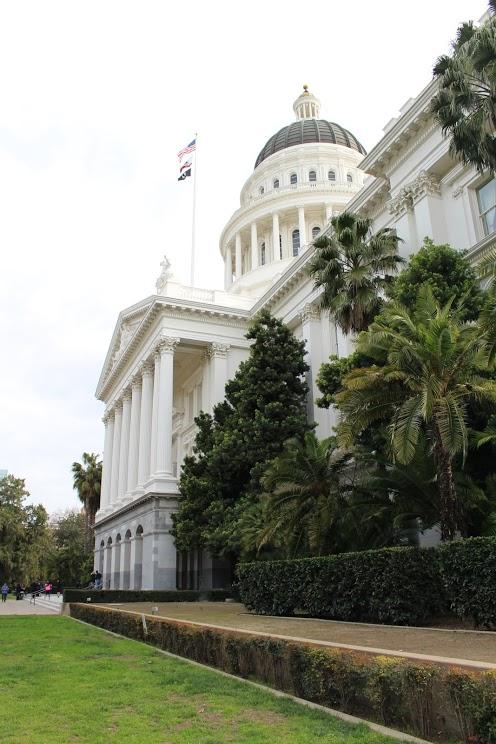A host of approximately 300 California community college students took to the Capitol Building in Sacramento March 2 in a rally and impromptu march for legislative and institutional action on student supplications, educational security and affirmed student influence among them.
Dubbed March in March, the rally has been an annual tradition in Sacramento since the 2008 financial crisis, drawing considerably larger crowds in past years when budgetary cuts were more acute, said Joshua Pinaula, SRJC associated students (AS) president, who attended two previous rallies.
“This event was meant to be a smaller thing,” Pinaula said.
“Students united, will never be divided!” chanted from the throng of delegates from the 112 community colleges in California.
A dozen or so tents stood erect on the veranda at the base of the Capitol Building, sporting banners of various student groups, including the Spectrum Caucus, an LGBTQ advocacy coalition, and the Black Student Caucus.
The rally began at 9 a.m. with students brandishing signs reading, “Power to the people,” “Don’t cut our future” and, “Money 4 war but not education?”
The Student Senate for California Community Colleges (SSCCC) orchestrated the rally. Its president, Omar Paz Jr., is also the SRJC student trustee and former AS president.
“We are the largest college student constituency in the country and we are very underserved,” Paz said. His objective for the event was to engage students in advocacy at the capitol.
In a speech addressing the crowd of students, educators and advisors congregated at the Capitol building, Paz said, “As community college students we have 2.1 million constituents, we have 112 schools. We are the largest college system in the country.”
The SRJC delegation had an audience with California State Assemblymen, Mark Levine, who represents Marin County and southern Sonoma County.
Levine asked how he plans to address the considerable cost of non-tuition expenses of community college students, like textbooks. Levine said he didn’t have any specific solutions but thinks paying for parking is ridiculous and education is underfunded.
“We need more money for education,” Levine said. “I think the book thing is a publishing racket.”
A product of the JC system, Levine praised community colleges. “Community colleges do a great job of career training,” he said.
Levine shared his dissatisfaction with the high amount of adjunct instructors employed in the JC system. Adjuncts are part time educators compensated directly for the units they teach, unlike tenure educators who are full time faculty and can realistically dedicate more time to their students.
“The [adjunct] system doesn’t work very well for them, or for you, the students,” Levine said.
The event was originally planned to be a student forum with a series of speeches, legislative visits and networking opportunities. The itinerary included no actual march.
However, Keith Montes, the chair of the Inter Club Council (ICC) at Diablo Valley College, led an impromptu march from the Capitol building to the California Community College Chancellor’s office several blocks away at 10:15 a.m.
Some 100 to 150 students marched with Montes to voice their grievances and concerns outside the office doors.
“Throughout the history of this country, the only time we have accomplished change is when large groups of people get together to make demands,” Montes said.
One of Montes’ chief demands was to recoup the 500,000 students lost in the community college system since 2008. “We should not sit here and be complicit,” Montes said. “We have more than enough money,” referring to state resources.
John Michaelson, president of legislative affairs at Diablo Valley College, used the march to criticize class repeatability laws, which limit the amount of times students can take certain classes.
“The repeatability law is wrong and it kills art,” Michaelson said, claiming art students sometimes need to take the same classes multiple times and are impeded by law.
“We live in a new world where higher education is everything,” Michaelson said. “This is our time, this is March in March!”
The ICC Vice Chair at Santa Monica City College, Courtney King, said, “I think this march is very important.” She adamantly supported increasing student representation in government.
“We can’t even touch the American Dream without a degree,” King said, advocating greater college access and security for students.
Student input consistently indicated that just marching and rallying isn’t sufficient to advance student interests.
Nicole Harris, student president at Skyline Community College in San Bruno and treasurer of the Black Student Caucus, called for students to do their part for the communal good.
“In order to help others, we need to speak out. Voting is your voice,” Harris said. “We are the ones who will change the future.”
Harris said, “The time is now, the power is now, the collective will is now.”
Ryan Camero, a San Joaquin Delta College student and outreach coordinator of the California Student Sustainability Coalition, said his objective at the rally was “to put the pressure on legislators to respond to the effects of climate change.”
“Our student body really cares about these things on a state-wide level,” Camero said. “There needs to be heavy concentration on this.”
Nehasi Lee, the Black Student Caucus’ current president, said he attended the event with “a purpose to represent interests of African descent and all other students.”
LGBTQ proponents converged at the Spectrum Caucus’s tent.
The Spectrum Caucus is an LGBTQ rights advocacy group, which promotes tolerance and acceptance of all sexual and gender identities.
Mara Javines, a member of the Spectrum Caucuses’ Antelope Valley College branch said, “Today we are pushing for equal access and equality, especially for trans students.”
Javines said transgender students are not adequately protected in the classroom and college athletics.
The Spectrum Caucus is “advancing social justice wherever possible,” Javines said.
SRJC President Dr. Frank Chong attended the rally. He said the rally was an opportunity for SRJC students to understand how the JC system is funded and they have a voice in decision-making.
“It’s very empowering to see all these students,” Chong said.
The rally ended shortly before 1 p.m. and consisted of a series of planned speeches and an open mic period. Legislative visits occupied the afternoon for many.
Demands for greater legislative attention and additional funds for community college services, along with student unity, appeared to be the common themes of the rally.
Tyrone Macedon Sr., student president at Moreno Valley Community College, said, “My expectation for the rally is that the legislature will see that community college students are serious about education.”
“It was very apparent that it was pulled together haphazard and I was prepared for that,” Pinaula said. “I think it was a good first step and I hope to see more of that in the future.”
Hilleary Izard, adviser of student affairs and categorical programs at SRJC, said of the rally, “I think it was worthwhile and effective.”
She admitted, however, the event was relatively disorganized and could have benefited from more student involvement and coordination.
Izard felt the students conveyed the message to legislators that higher education deserves attention.
SRJC Dean of Student Affairs, Robert Ethington, who is also an advisor to the AS Senate, attended the rally and said, “For me, students learning to put on a rally is as important as the outcome.”
Ethington said, “If you learn how to plan an event, you learn how to plan your life.”






